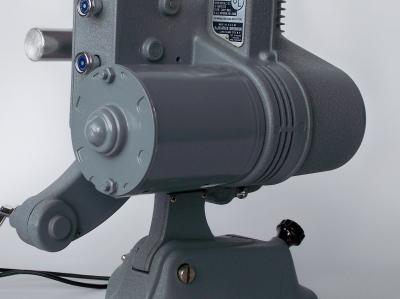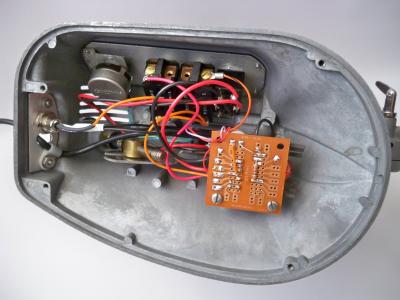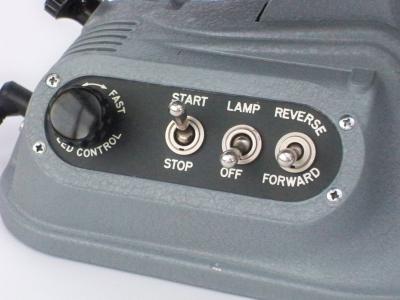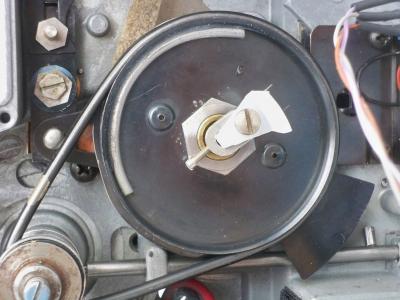Transportation
I remember running our old DeJUR in “slow motion.” Turning down the speed knob, the motor’s whine would drop into a lower register and you could easily see each frame go by. But don’t try to go too slow or the motor will stall and a little heat shield screen will drop into the light path and the image will be very dark. Of course, that heat shutter might stick and then we see the thrilling spectacle of a hole melting in the film, projected larger than life on screen.
Well, for the telecine, I don’t have to worry about anything melting. But I do need to run the projector slowly, since the camera and computer can’t capture fast enough to move the film at 18 frames per second.
The original motor speed control was just a rheostat, which didn’t provide very good regulation. If anything binds, the motor will slow down a lot. I tried using a sold state “Router Speed Control” but the old motor is just too small and weak for the job. It could not run slowly enough without stalling.
The only solution was a new permanent magnet DC motor, which sadly compromised the retro styling of the machine…
… but it runs smoothly and quietly at low speeds, from less than 1 to about 15 frames/sec, without stalling. I replaced the old rheostat with a voltage controlled PWM speed control, using a 555 timer chip, a comparator, and a power FET. The PWM circuit board fits neatly inside the base. Without the old AC motor, and the 750 watt lamp, the whole machine can now be powered by a 12 volt/5 amp AC adapter, so there is no AC wiring in the base any more…
… and everything on the neat old control panel still works as labeled …
The motor drives the shutter wheel through a rubber belt. The only change here is the removal of two of the three shutter blades, to give the camera more time for each capture. The remaining blade still blocks the light during the film advance, so I can watch a movie live on the computer without blurring. The extra blades were there to make the on screen flicker less annoying by raising its frequency. I added a bit of lead solder to the shutter wheel to balance the single blade, so the machine doesn’t vibrate when running fast…





Any chance you could pass along the places you acquired items like the voltage controlled PWM speed control?
This is great information, thanks for all the detail.
Comment by javapop — October 9, 2009 @ 4:47 am
javapop, the PWM controller is homemade. See the schematic diagram under "Computer". The PWM controller board contains the group of components at the very bottom of the schematic. Everything on the schematic should be easily located on Google. If you can't find some particular part, just ask.
Comment by Jim McGarvey — October 9, 2009 @ 12:50 pm
hi, can you post other image of pwm controller for dc motor? and the schematic diagram also? in computer section you have posted the schematic diagram of ccd circuit, isn’t it?
Comment by nonchiedercilaparola — January 30, 2011 @ 9:49 am
The schematic in the Computer section covers everything. The PWM power part is at the very bottom of the circuit. The BUZ11 FET is the power switch for the motor. The 555 and 331 chips in the center of the schematic produce the PWM waveform.
Sorry, I didn’t take any pictures of the top of the PWM circuit board. There are more pictures in the Photo Album.
Comment by jimmymc — January 30, 2011 @ 10:29 am
Please post the specifics of the permanent magnet DC motor.
Mgf.
Model No.
Any other details that might be helpful.
Finding a 16mm camera lens may be a little difficult.
Might a 35mm camera lens work? If so, what size?
Thanks for your Excellent information! Great results!
Comment by Gary — August 16, 2013 @ 4:26 pm
The motor came from an RV water pump. It’s rated 12VDC and I think 6 or 7 amps max. I don’t know the unloaded RPM or manufacturer.
Most people use 35mm camera or enlarger lenses. My main reason for the 16mm lens was to keep the optical path compact. The 17.5mm lens I used is a “normal” lens for 16mm format. You could get a 17mm lens for 35mm format, but it would be much larger and not as well corrected. But a normal lens for 35mm (40-50mm focal length) will make the optical path a 2x-3x longer than mine. That’s the tradeoff. There is no need for the coverage of a 35mm format lens, since the 8mm film frame and the CCD are so tiny. So the extra bulk of those lenses brings no benefit.
Comment by jimmymc — August 16, 2013 @ 4:45 pm